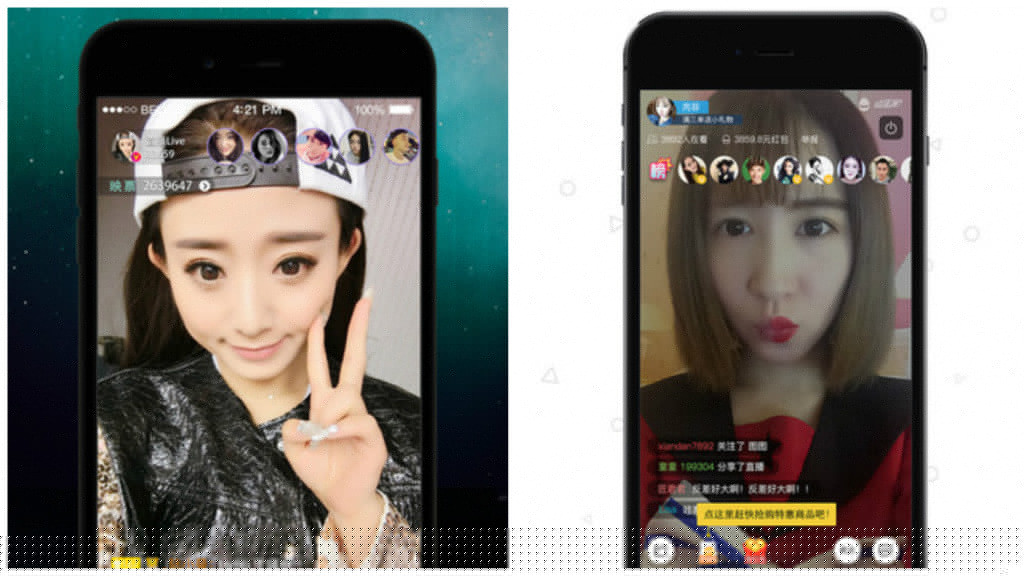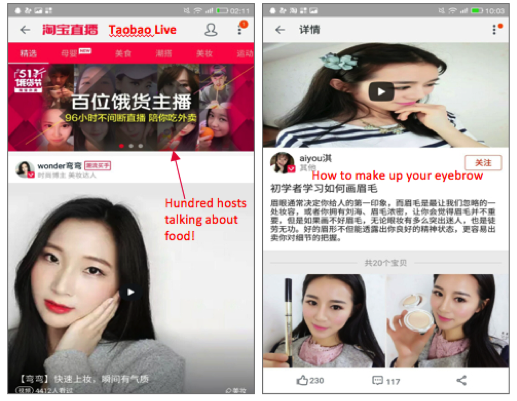Last Updated on May 10, 2024
Whether you’re into it or not, live streaming is something you’ve most certainly come across in China.
Not to say that live streaming doesn’t exist elsewhere (it does), but these forms of mobile self-expression somehow always seem to excel over here.
Maybe that has something to do with the popularity of internet celebrities in China, built upon the success of social media KOLs.
All we know for sure is that watching attractive girls eat their lunch while discussing their hobbies and singing along to their favorite songs is something that reunites thousands (if not millions) of Chinese internet users on a daily basis.

But before you write this off as a one-hit wonder, a short-spanned phenomenon similar to that of music dubbing on Dubsmash, you better think twice.
It’s widely reported that by the end of June 2016, over 46% of all Chinese internet users (roughly 325 million users) had used a live streaming app and as incredible as it may seem, Credit Suisse claim the Chinese personal live streaming market will be worth $5B next year.
That’s just $2B less than China’s box office total and half the worth of the mobile gaming market.

The live streaming craze certainly seems here to stay and if you don’t want to end up like an ignorant old fool rambling on about the good old days, you’d better come to terms with it… Fast. But don’t despair, for we have written this guide specifically for you.
Out of all the questions that could be asked, I’m guessing the one you’re really racking your brain over is “Seriously though, why do people watch?” Am I right?
Fortunately for you guys, I asked myself the same question over and over again and consequently scoured the internet in search of an answer. What I found out will blow your mind. (Clickbait at its best).
Why do people watch?
The most existential questions of humanity revolve around the purpose of our existence and this one’s definitely up there with the rest. (Cough-cough-chuckle).
No but seriously though, how can something as ordinary as someone eating pasta draw such a crowd?

Alright so basically, live streaming in China differs from live streaming in the US and Europe in the sense that it promotes inward capture rather than outward capture. Sounds technical eh? It’s not.
In other words, western live streaming broadcasters record live events using the camera on the back of their phones whereas their Chinese counterparts film their face. In many ways, live streaming in China is a sort of video selfie in which the broadcaster and viewers communicate through interactive tools enabled by the app.
So what are these interactive tools?
Live streaming viewers can interact with broadcasters by either asking a public question, similar to what you could find in a live chat room, or by offering digital gifts in the hope of attracting their attention.
On their side, broadcasters have the option to respond to their viewers’ questions or requests.
For instance, let’s say a viewer sends the broadcaster a digital sticker of a sports car (these can cost over $30 apiece but we’ll get into the financials in the next section) and then asks him or her to do the Macarena on the kitchen table.
If that broadcaster is in a good mood, he or she will thank the viewer for the gift and honor their request, much to the appreciation of the other viewers.

This kind of interaction is a win-win for all involved. The viewer feels acknowledged, the broadcaster is financially incentivized and the rest of the audience is entertained.
As you can imagine based on this example, much of the broadcaster’s content is dictated by viewer requests.
Another feature that greatly encourages viewers to engage is the use of leaderboards within the app. Broadcasters are obviously ranked based on their current number of viewers, money earnt and general trendiness, but what’s really unique to China is that the viewers themselves are ranked!
For each individual broadcaster, there’s a leaderboard that highlights the top fans based on the total value of digital gifts offered. No, I’m not joking. Yes, viewers DO genuinely compete to be the biggest spender.
These financial incentives bring us to the next burning question…
Why do broadcasters film themselves?
Alright, so let’s get the obvious out of the way. Broadcasters don’t just do this for the hell of it, they get paid. And in some cases, they get paid A LOT. According to ABC News, certain broadcasters earn as much as $20k per month.
Where does the money come from?
You remember that digital sticker of a car I mentioned earlier?
Alright so let’s say the sticker costs the viewer $30. Those $30 will be split between the broadcaster, the app store and the live streaming app in question. These digital gifts vary in price and some can cost as much as several hundred US dollars.
But that’s not the only way they can make money. Popular broadcasters with a strong follower base are much like WeChat & Weibo influencers and are therefore KOLs in their own right. Certain social media KOLs have also become broadcasters in an aim to work with more brands.
This is particularly true in the beauty industry in which more and more fashion & makeup brands are asking broadcasters to share their products with their followers through tests and reviews.

As you can see, broadcasters are certainly financially incentivized to record their everyday lives, but that’s not the only factor that motivates them to do so. The lure of fame, boredom and a desire to make friends are the other factors most broadcasters agree on.
Now with all due respect, I also get bored from time to time but have never contemplated filming myself eating bananas. As luck would have it, the Chinese government just recently implemented a ban on what they call “suggestive banana eating”. True story.

How are brands leveraging live streaming?
As mentioned above, popular broadcasters have all the ingredients required to become KOLs, or ambassadors, for brands looking to promote their products or services on social media.
Chinese broadcasters are much like Western vloggers and constitute an interesting promotion channel, particularly if they’re specialized in a specific topic and are followed by a specific target market.
But brands don’t limit themselves to working with broadcaster KOLs and those who are more in tune with Chinese social media behavior broadcast their own live streams.
Let’s take Oreo for example. During the launch of their double-chocolate flavored biscuits, Mondelez called on two popular Chinese signers who were recorded munching on Oreo biscuits while singing the list of ingredients to the tune of a love song. This was all live of course and as we’ve come to expect by now, the show got 4.5 million unique live views and supposedly set a sales record for Oreo on Tmall.
Xiaomi on the other hand decided to take a more boring approach (their words not mine). To showcase the impressive battery life of its Mi Max phablet, the company ran a continuous stream on Bilibili that lasted 19 days, until the battery finally died. Say what you will but at one point, 39 million people were actually watching the show! No you’re not mistaken, 39 million people actually witnessed a mobile phone running out of battery.

Last but not least, and this has to be one of the weirdest marketing campaigns of all time, Durex recorded a live show with 50 couples in bed. Relax, there was nothing sexual or pornographic about it. Instead, the couples engaged in calisthenics and snacked on bananas. Yep, just another day in digital China, right?
If that wasn’t enough, ecommerce companies are also entering the space. Taobao have launched a separate app called “Taobao Live”, in which viewers can watch sellers promoting and reviewing their merchandise while JD.com recently broadcasted a live lobster-cooking competition on Douyu. The competition was watched by 5 million viewers and apparently resulted in a significant increase in lobster sales during that 12-day period.

The success of live streaming isn’t all that surprising in the grand scheme of things. Shows such as Big Brother and Jersey Shore have been taking over the planet for the last few years (as much as we may regret it) and if live streaming isn’t the mobile equivalent of reality TV, I don’t know what is.
The whole concept can be hard to comprehend and by no means do I consider myself an advocate for live streaming. However, who can blame broadcasters? It’s free for them, relatively non time-consuming (they’ll do what they’re doing anyway, whether filmed or not), requires zero preparation (live streaming apps come with makeup correctors and so on) and they get money from it.
I guess the real mystery here is why do fans become so attached to these unknown broadcasters and what really encourages them to spend their hard-earned cash.

Some will say it’s a social phenomenon caused by the fact that China boasts many migrant workers living far from home who search for connections online while others will say it’s all just a flirt game. Indeed, it has to be said that while females make up approximately 80% of all broadcasters, males account for pretty much 80% of all app users.
All in all, what’s for sure is that the craze shows no signs of slowing down soon, an increasing number of brands are leveraging this new social media channel to promote their products on mobile and broadcasters are getting rich overnight.
And now you know all there is to know about live streaming in China.
In need of a short recap?
Why do people watch live streaming?
– They enjoy the interactions these apps enable with the broadcaster.
– Interactions make them feel acknowledged.
– Yearn to be their favorite broadcaster\’s most active fan.
Why do broadcasters film themselves?
– Lure of fame.
– Boredom.
– Desire to make new friends.
– And of course financial incentives.
Where does the money come from?
– Digital gifts offered by viewers.
– KOL marketing.
How are brands leveraging live streaming?
– By working with popular live stream KOLs.
– By broadcasting their own streams as part of their marketing campaigns.
– E-commerce companies are encouraging sellers to promote their products through live streams.
YOU MAY ALSO LIKE
- mobile game marketing
- wechat search
- wechat index
- baidu marketing
- WeChat CRM

